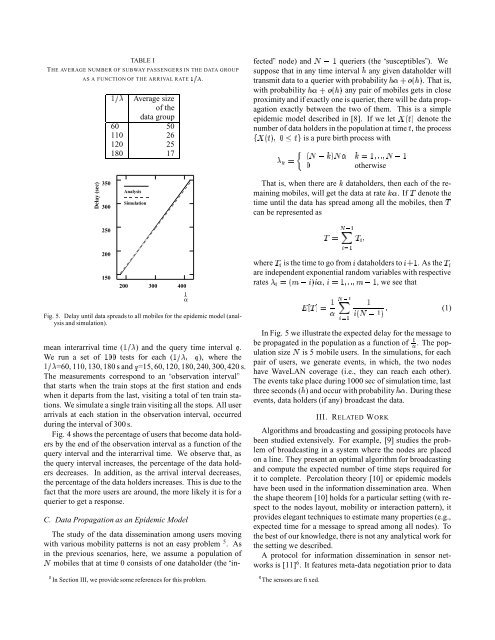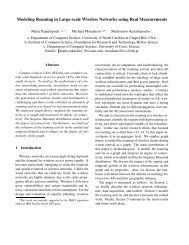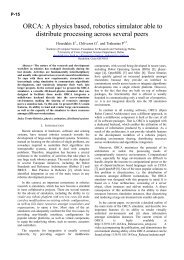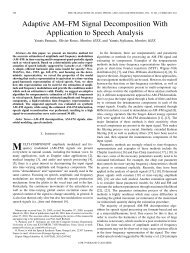Seven Degrees of Separation in Mobile Ad Hoc Networks - ICS
Seven Degrees of Separation in Mobile Ad Hoc Networks - ICS
Seven Degrees of Separation in Mobile Ad Hoc Networks - ICS
Create successful ePaper yourself
Turn your PDF publications into a flip-book with our unique Google optimized e-Paper software.
¦<br />
&<br />
&<br />
<br />
<br />
¥<br />
<br />
<br />
<br />
<br />
<br />
.<br />
<br />
. 3<br />
&<br />
TABLE I<br />
THE AVERAGE NUMBER OF SUBWAY PASSENGERS IN THE DATA GROUP<br />
AS A FUNCTION OF THE ARRIVAL RATE § ¨ .<br />
Average size<br />
£¦<br />
<strong>of</strong> the<br />
data group<br />
60 50<br />
110 26<br />
120 25<br />
180 17<br />
fected” node) and queriers (the “susceptibles”). We<br />
£<br />
suppose that <strong>in</strong> <strong>in</strong>terval¤<br />
any time any given dataholder will<br />
transmit data to a probability¤¦¥¨§© <br />
querier with . That is,<br />
£¢<br />
<br />
with any pair <strong>of</strong> mobiles gets <strong>in</strong> close<br />
proximity and if exactly one is querier, there will be data propagation<br />
exactly between the two <strong>of</strong> them. This is a simple<br />
probability¤¥§©<br />
epidemic model described <strong>in</strong> [8]. If<br />
¡¤<br />
we denote the<br />
¡<br />
number <strong>of</strong> data holders <strong>in</strong> the population at time, the process<br />
¡¤<br />
let<br />
¡¦<br />
is a pure birth process with<br />
<br />
¡<br />
<br />
£<br />
¦¦¢ £<br />
otherwise<br />
¨<br />
Delay (sec)<br />
350<br />
300<br />
Analysis<br />
Simulation<br />
¡¢<br />
That is, when there<br />
<br />
dataholders, then each <strong>of</strong> the re-<br />
<br />
are<br />
ma<strong>in</strong><strong>in</strong>g mobiles, will get the data rate at<br />
time until the data has spread among all the mobiles,<br />
¥<br />
can be represented as<br />
then<br />
If denote the<br />
250<br />
&¦<br />
200<br />
150<br />
200 300 400<br />
1_<br />
α<br />
is the time to go the<br />
from)dataholders . £ As<br />
are <strong>in</strong>dependent exponential<br />
where<br />
random variables with respective<br />
£<br />
<br />
to)§<br />
£ rates , we see that ¢ ¦.¦* ¢,))¥ ,)- ¡+* <br />
"!$# %&('<br />
<br />
<br />
(1)<br />
Fig. 5. Delay until data spreads to all mobiles for the epidemic model (analysis<br />
and simulation).<br />
mean <strong>in</strong>terarrival (£ time ) and the query time <strong>in</strong>terval .<br />
We run a set £§ <strong>of</strong> tests for (£¦ each ), where the<br />
=60, 110, 130, 180 s and =15, 60, 120, 180, 240, 300, 420 s.<br />
£<br />
The measurements correspond to an “observation <strong>in</strong>terval”<br />
that starts when the tra<strong>in</strong> stops at the first station and ends<br />
when it departs from the last, visit<strong>in</strong>g a total <strong>of</strong> ten tra<strong>in</strong> stations.<br />
We simulate a s<strong>in</strong>gle tra<strong>in</strong> visit<strong>in</strong>g all the stops. All user<br />
arrivals at each station <strong>in</strong> the observation <strong>in</strong>terval, occurred<br />
dur<strong>in</strong>g the <strong>in</strong>terval <strong>of</strong> 300 s.<br />
Fig. 4 shows the percentage <strong>of</strong> users that become data holders<br />
by the end <strong>of</strong> the observation <strong>in</strong>terval as a function <strong>of</strong> the<br />
query <strong>in</strong>terval and the <strong>in</strong>terarrival time. We observe that, as<br />
the query <strong>in</strong>terval <strong>in</strong>creases, the percentage <strong>of</strong> the data holders<br />
decreases. In addition, as the arrival <strong>in</strong>terval decreases,<br />
the percentage <strong>of</strong> the data holders <strong>in</strong>creases. This is due to the<br />
fact that the more users are around, the more likely it is for a<br />
querier to get a response.<br />
C. Data Propagation as an Epidemic Model<br />
The study <strong>of</strong> the data dissem<strong>in</strong>ation among users mov<strong>in</strong>g<br />
with various mobility patterns is not an easy problem 5 . As<br />
<strong>in</strong> the previous scenarios, here, we assume a population <strong>of</strong><br />
mobiles that at time 0 consists <strong>of</strong> one dataholder (the “<strong>in</strong>-<br />
¡In Section III, we provide some references for this problem.<br />
£<br />
0 ¥ !1# %&('<br />
<br />
/<br />
£<br />
£ )¡2¢<br />
In Fig. 5 we illustrate the expected delay for the message to<br />
be propagated <strong>in</strong> the population as a function <strong>of</strong> The population<br />
size is 5 mobile users. In the simulations, for each<br />
pair <strong>of</strong> users, we generate events, <strong>in</strong> which, the two nodes<br />
have WaveLAN coverage (i.e., they can reach each other).<br />
The events take place dur<strong>in</strong>g 1000 sec <strong>of</strong> simulation time, last<br />
three seconds ) and occur with probability¤¥<br />
. Dur<strong>in</strong>g these<br />
events, data holders (if any) broadcast the data.<br />
(¤<br />
III. RELATED WORK<br />
Algorithms and broadcast<strong>in</strong>g and gossip<strong>in</strong>g protocols have<br />
been studied extensively. For example, [9] studies the problem<br />
<strong>of</strong> broadcast<strong>in</strong>g <strong>in</strong> a system where the nodes are placed<br />
on a l<strong>in</strong>e. They present an optimal algorithm for broadcast<strong>in</strong>g<br />
and compute the expected number <strong>of</strong> time steps required for<br />
it to complete. Percolation theory [10] or epidemic models<br />
have been used <strong>in</strong> the <strong>in</strong>formation dissem<strong>in</strong>ation area. When<br />
the shape theorem [10] holds for a particular sett<strong>in</strong>g (with respect<br />
to the nodes layout, mobility or <strong>in</strong>teraction pattern), it<br />
provides elegant techniques to estimate many properties (e.g.,<br />
expected time for a message to spread among all nodes). To<br />
the best <strong>of</strong> our knowledge, there is not any analytical work for<br />
the sett<strong>in</strong>g we described.<br />
A protocol for <strong>in</strong>formation dissem<strong>in</strong>ation <strong>in</strong> sensor networks<br />
is [11] 6 . It features meta-data negotiation prior to data<br />
4The sensors are fixed.
















